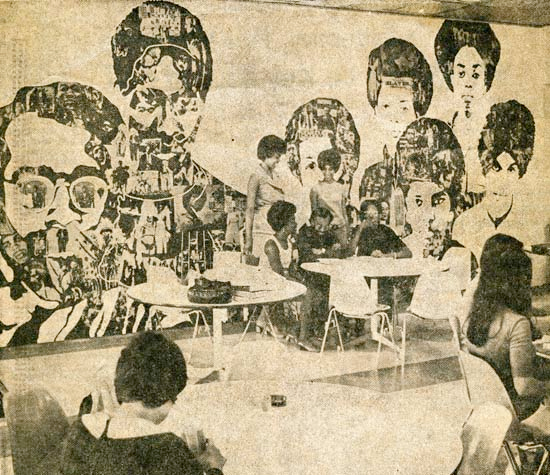Student group pushes for exposure of ‘The Black Experience,’ a mural hidden in Ackerman for more than 20 years

By Estefani Herrera
Feb. 22, 2013 1:33 a.m.
The original headline contained information that was unclear and has been changed. See the bottom of the article for additional information.
Hidden behind a false wall and a fast-food restaurant, large black and brown images depict the faces of seven UCLA alumni, symbolizing the struggle of social activism and black history.
The 40-year-old mural, called “The Black Experience,” has been blocked from view for more than two decades. But now, several students want that to change.
Last quarter, the Afrikan Student Union asked Associated Students UCLA to consider different ways to restore the mural or remove the false wall, currently located next to Panda Express on the first floor of Ackerman Union.
The mural portrays the faces of the seven original artists of the mural. Within the shadows of the artists’ faces are superimposed images of key figures and events in black history, leaving the effect that these images make up the faces of the artists.
Students in the group want to either relocate or restore the mural because they value its depiction of the historical black experience on campus, and because it is a reminder of social activism at UCLA, said Jason Smith, a former ASU member who is spearheading the movement to unveil and preserve the mural.
In the spring of 1970, thousands of UCLA students protested the deaths of four Kent State University students.
The demonstrations left buildings such as Campbell Hall and Ackerman Union marred by broken windows and graffiti, according to Daily Bruin archives. Similar activity on other campuses forced then-Gov. Ronald Reagan to shut down colleges and universities statewide for four days, including UCLA.
After the protests subsided, seven graduate and undergraduate art students collaborated to design and create the mural. The project aimed to leave behind something positive in the wake of the damage and chaos of the student riots, according to Daily Bruin archives.
In 1992, the mural was covered by a false wall during a remodel of Ackerman Union, according to Daily Bruin archives.
During the construction of the false wall, several holes were drilled directly into the mural, said Roy Champawat, director of the UCLA Student Union. Panda Express also covers up the right border of the mural, making it less visible, he said.
Smith said he read an article in the Daily Bruin in May 2010 about the mural, which had not been seen in Ackerman for almost 20 years.
Last quarter, the fifth-year world arts and cultures student enrolled in a world arts and cultures course titled “Beyond Mexican Mural: Beginning Muralism and Community Development,” which inspired him to actively try to unveil the mural.
“The professor really wanted us to focus on art, specifically monuments like murals (that) speak about human experiences and social issues,” Smith said. He said the course reminded him of “The Black Experience” mural he had read about two and a half years before.
Motivated by the class, Smith brought the mural to the attention of ASU. Together, Smith and ASU then brought the mural to the attention of ASUCLA Board of Directors at a meeting last quarter.
Jacob Ferrari, a fourth-year American literature and culture student and chair of the ASUCLA services committee, said the mural would allow students to see how UCLA has been involved in issues of social justice.
“The mural is student art, and it’s an important look at the cultural, racial evolution of the campus,” said Champawat.
ASUCLA is currently in the process of deciding how to proceed with the mural, Champawat said.
He said ASUCLA representatives met with art preservationists from the Getty and Fowler museums earlier this quarter to figure out a way to restore the mural to public view.
The preservationists are hoping to bring in the original artists to learn how they created the mural and what the best way to repair the holes would be, said Christian De Brer, the head of conservation at the Fowler Museum.
Because the mural is painted directly onto the wall, removing it from its current location would be difficult, De Brer said.
Another option would be to remove the false wall and incorporate the mural into the decor of Ackerman, he said.
But it is still too early in the process to determine what exactly will be done or how much the restoration will cost, Champawat said.
He also said ASUCLA representatives are still looking into how the preservation would affect the building’s structure.
Ferrari expressed that he has no preferences about the logistics of the project, but hopes the mural can eventually be restored.
“It’s definitely a project that deserves to be displayed, and should be appreciated by the entire student body instead of the few who know that it’s there,” Ferrari said.
Contributing reports by Erin Donnelly, Bruin senior staff.
Clarification: There are currently no definitive plans to expose the mural.


